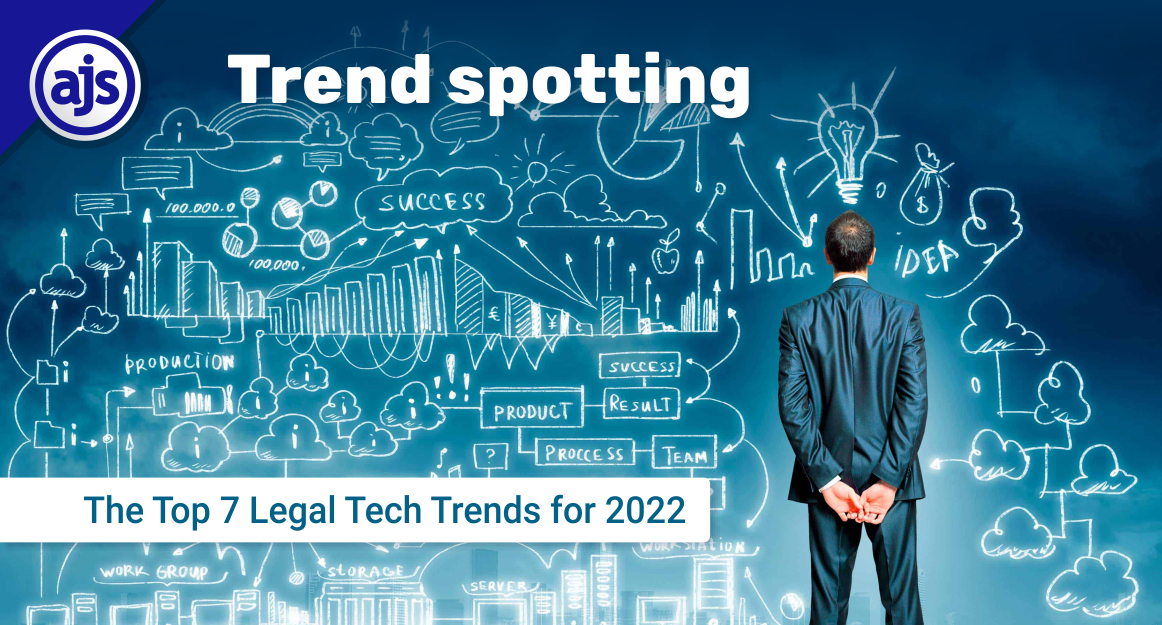
TREND SPOTTING
The “Top 7” legal tech trends for 2022
At the start of 2020, no one could have predicted all the positives that would arise from the difficulties we have all experienced over the last two years.
But now at the start of 2022 – almost two years later – law firms have thrived. Work from home (or remote work) and hybrid models of work turned out to be better than anyone could have predicted. The increased adaptation of technology and use of data resulted in improved efficiency, accuracy and affordability, which in turn enabled a higher engagement with clients (resulting in an almost merging of businesses with their legal teams).
As a result revenues increased and together with the elimination of travel, events and other costs (like office rental and overheads) led to higher profits.
During all of this, the legal industry proved both to the world in general and to legal practitioners specifically, that the legal industry can change, grow and adapt. All while maintaining high standards of client service. Seemingly, the legal industry is working “smarter” (in the true sense of the word) than it ever has before.
And that is amazing!
Now as we look ahead, the question as to whether we can thrive during times of uncertainty have been answered in a resounding “Yes”. So as we begin to grapple with the nuances of the New Year, it’s more crucial than ever to stay up to date and on-top of legal technology trends, focusing our attention away from simply reacting and regrouping because of the pandemic and instead looking at how to be (and remain) successful in 2022 (and beyond) despite the pandemic.
The “Top 7” Legal tech trends
You will not find a business or industry today that did not benefit from engaging in and embracing technology into its daily operations. And none more so than in the legal space.
Legal tech (today especially), touches almost every aspect of the legal process that lawyers are involved in on a daily basis. Lawyers have seen the benefit of (and are most certainly reaping the rewards of) using legal tech to its best advantage, helping them execute their work in a more efficient, accurate and affordable way.
But, as we all know, technology doesn’t remain stagnant. It constantly evolves. Therefore remaining on top of the most important legal tech trends becomes tough. Because of this, legal tech will remain firmly on the strategic plan agenda, forming a key focus for legal departments and law firms alike.
We know there is a lot to take in. But fear not, we have put our heads together and have come up with 7 legal tech trends to keep your eyes on in 2022 –
1. Contract & Document Automation
Contract and document automation remain some of the most popular (and common) legal tech trends in the legal industry today. Let’s be honest, there is hardly anyone who doesn’t use at least one application during their day-to-day tasks.
Contract and document automation has significantly decreased the time it generally takes to execute contracts and produce various documents, thereby making everyday tasks a cinch. Popular use cases include the preparation of NDA’s, employment contracts, lease agreements, procurement contracts, engagement letters and so much more.
Furthermore with the right choice of application, many processes proceed with little to no effort. This in turn means that more time can actually be spent on building client relationships rather than spending time on time consuming tasks.
This, as you can imagine, is incredibly beneficial when reducing costs, protecting revenue, optimising headcount and reducing overall risk. Moreover, as technologies continue to evolve to include a range of different file and data types, traditional ways of operating will be challenged forever.
With the additional use of cloud-based document automation, data is seamlessly integrated into templates which populate signature-ready documents instantly. Through programming language and automation technology, precise and accurate documents can be drafted in a single click.
XpressDox is perfectly poised to take your legal practice to the next level. It is a powerful document assembly system handling your document automation needs with ease. It can be used as a stand-alone product, on a network, via the web (own-hosted or XpressDox-hosted), or even from within your own application or website. It’s that versatile.
2. Workflow Automation
Workflows are clear, predetermined, and structured processes within which a worker receives, reviews and performs a task.
Therefore, automated legal workflows are the processes in which legal tech is utilised to facilitate, structure, and streamline the performance of repetitive and labour intensive legal tasks. As with contract and document automation, the main benefits of legal workflow automation includes saving time, reducing human errors and driving efficiencies whilst enhancing client service delivery. All win-win.
Workflow automation software expedites some of the most labour-intensive tasks of running a law firm. Instead of retyping a long document or spending hours reformatting, you can simply upload your document and the workflow tech does the rest. Easy peasy.
FLOW is specifically designed for this very purpose. It automates repetitive processes and increases throughput by improving control and ensuring accuracy. It is also a standalone, configurable workflow system that is perfect for any process that has a defined set of steps or stages. Better still, it can be easily accessed via the Cloud.
AJS Pro and AJS Enterprise both contain the ability for configurable embedded workflow solutions as part of the AJS financial and practice management solutions.
3. Regulatory Technology
Regulatory Technology or “RegTech “is not just a buzzword, it is something that is already having a major impact on regulatory compliance.
RegTech is a category of technology that assists organisations to effectively navigate different functions within the regulation landscape. This includes functions such as regulatory reporting and compliance, risk management, identity management and monitoring transactions.
According to Deloitte, RegTech tools for compliance combine regulation, risk assessment and risk management into a sort of compliance collaboration platform. They monitor and identify changes in the regulation landscape, evaluate the impact and disseminate the relevant information to the relevant department in a timely and efficient manner.
RegTech therefore streamlines the collation, assessment and reporting processes to ensure compliance whilst managing and mitigating potential risks.
Looking to the future, a greater emphasis on RegTech solutions that combine machine learning technology and rules-based automation with a focus on highly practical applications, will most certainly come to the fore.
4. Cloud-computing
Keeping a vast amount of data organised in an efficient and accessible manner is an absolute necessity. Lawyers specifically deal with a lot of information, operating many documents and analysing a big scope of data. Thus, the importance of cloud-based storage for legal professionals cannot be over-emphasised.
Hosted cloud servers are really nothing new, but the legal market has been slow to migrate their data to the cloud because of security concerns. But now with improved security measures, cloud-based storage has become increasingly more attractive to legal professionals allowing them to fully operate remotely (and in the cloud) whilst also providing teams with more opportunities for online collaboration.
AJS is already ahead of the curve. Why? Well AJS products are already cloud-based which means that authorised users can access their system securely from anywhere, on almost any device.
5. Cybersecurity
According to the article Ransomware in 2022: We’re all screwed –
“Over the past few years, we’ve seen ransomware operators evolve from disorganized splinter groups and individuals to highly sophisticated operations, with separate teams collaborating to target everything from SMBs to software supply chains.
Ransomware infection is no longer an end goal of a cyberattack. Instead, malware families in this arena — including WannaCry, NotPetya, Ryuk, Cerber, and Cryptolocker — can be one component of attacks designed to elicit a blackmail payment from a victim organization”.
The European Union Agency for Cybersecurity (ENISA) have said that there was a 150% rise in ransomware attacks between April 2020 and July 2021. According to the agency, we are experiencing the “golden era of ransomware” and there are fears that despite the problem of ransomware attracting the attention of world leaders, the problem will get far worse before it gets better.
Ransomware is thus the most significant cybersecurity threat facing businesses today. Professional cyber criminals (aka “hackers”) have become far more sophisticated in order to maximise the amount of money that can be made from cyber-attacks. It’s likely that the success of ransomware campaigns will only encourage more hackers to get involved with ransomware, particularly when it comes to hands-on operations that can cripple an entire network.
Hackers trigger a ransomware attack by secretly compromising networks (often via phishing attacks, compromising cloud services or exploiting vulnerabilities) before installing file-encrypting malware across as many systems as possible. Victims are locked out of files and servers and the cyber criminals demand a ransom payment (often to be made in cryptocurrency) in exchange for the decryption key. In many cases, the victim pays just to get their systems under their control and their businesses operational once again. But that payment only serves to fuel the ransomware industry.
Unfortunately, attacks against law firms are also on the rise. Hackers realise that the confidential nature of law firm data can help them extort large ransoms from victims who want to quickly and quietly regain control of their networks.
Defending against ransomware is a two-prong process that starts with developing a strong information governance program to prevent an attack from succeeding and having the right threat intelligence and tech in place to prevent cybersecurity attacks.
¬ Helpful Hint – to properly protect your software and valuable data from Ransomware and cyber-attacks, it is advisable to work together with a reputable data centre, such as Teraco Data Environments together with a reliable software provider, such as AJS (an ideal combination).
6. Data Management
According to the Oxford Dictionary, data is defined as “a set of facts, stats or statistics collected for reference or analysis”.
In more complex terms, data (according to TechTarget network), is “information that has been translated into a form that is efficient for movement or processing”.
With the use of various social media platforms (amongst other things), we are not only constantly collecting and sharing data (whether intentionally or not) but today’s digital economy has access to more data than ever before. Data is therefore increasingly seen as an asset that can be used to make more-informed business decisions, improve marketing campaigns, optimise business operations and reduce costs, all with the goal of increasing revenue and profits.
And whether lawyers are aware of it or not, the legal industry is a treasure chest of data, from the information collected from clients, court documents, any form of legal document, to client lists, statutes and many more important and often confidential pieces of information.
Data therefore needs to be effectively managed by collecting, organising, protecting, maintaining and storing data (in a way that improves its reliability, scalability and security) so that it can be properly analysed for important business decisions. As organisations create and consume data at unprecedented rates, data management solutions become essential for making sense of vast quantities of data. And this needs to be done securely. Especially since it is considered a category of compliance obligations.
For enterprise legal functions that support or are also responsible for data protection, responses to this challenge go beyond the usual expectation of simply monitoring rules and drafting policies simply for compliance sake – because how data is actually managed (especially as lawyers) is absolutely crucial.
Ensuring data is securely stored and is effectively protected from cyber-attacks should be a top priority.
7. Blockchain Technology
Blockchain technology together with contract and document automation have the potential to make legal frameworks even more robust. But blockchain technology goes one step further by providing a hacker-proof network to exchange information and by so doing makes blockchain hard to ignore. Aside from network security, smart contracts over blockchain can help speed up legal processes by automating and executing legal contracts without human intervention or manipulation, taking simple automation that one step further. “Fancy shmancy” indeed.
Blockchain technology is closely associated with Bitcoin. We admit that. It is, in fact, the underlying tech that allows for the virtual currency’s existence. But, from a legal perspective, blockchain technology provides a digital ledger of transactions that can be documented, distributed, and duplicated (but not edited).
And for some legal departments that are struggling under the burden of excessive paperwork and records, the integration of blockchain technology to store information in a transparent and precise fixed ledger rather than a centralised database is a game changer.
For many, blockchain technology represents the “fourth industrial revolution” characterised by decentralised digital contracts that allow simultaneous real-time access, preserve modifications, and enhance distribution security.
Closing comments
It is evident that the trends in the legal tech space were initially brought about due to the rapid changes wrought upon the global economy during the last two years. There was a necessity to organise legal processes in a way that worked virtually. And that was a challenge. But there is no denying that technology and innovation have played (and will continue to play) a critical role in shaping the future of the legal sector.
By all indications, this year will bring about even more innovation within the legal industry. Which is extremely exciting. And the added bonus here? The increased adoption of advanced legal tech by legal departments and law firms alike will fuel further research, investment and innovation. The sky is the limit here. It would seem…
And we believe that makes for a very exciting year ahead.
So, brace yourself.
– Written by Alicia Koch on behalf of AJS
12 Comments
-
Pingback: Work Zen with AJS - AJS South Africa
-
Pingback: Risk and Compliance - AJS South Africa
-
Pingback: THE TECH SERIES - AJS South Africa
-
Pingback: The Zen of Work: DATA - AJS South Africa





Pingback: SLEEP WHEN YOU’RE DEAD? - AJS South Africa